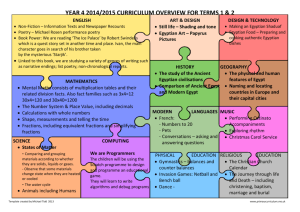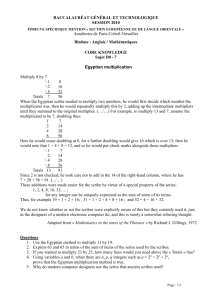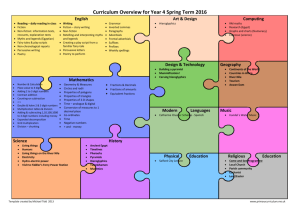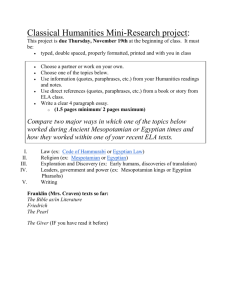File
advertisement
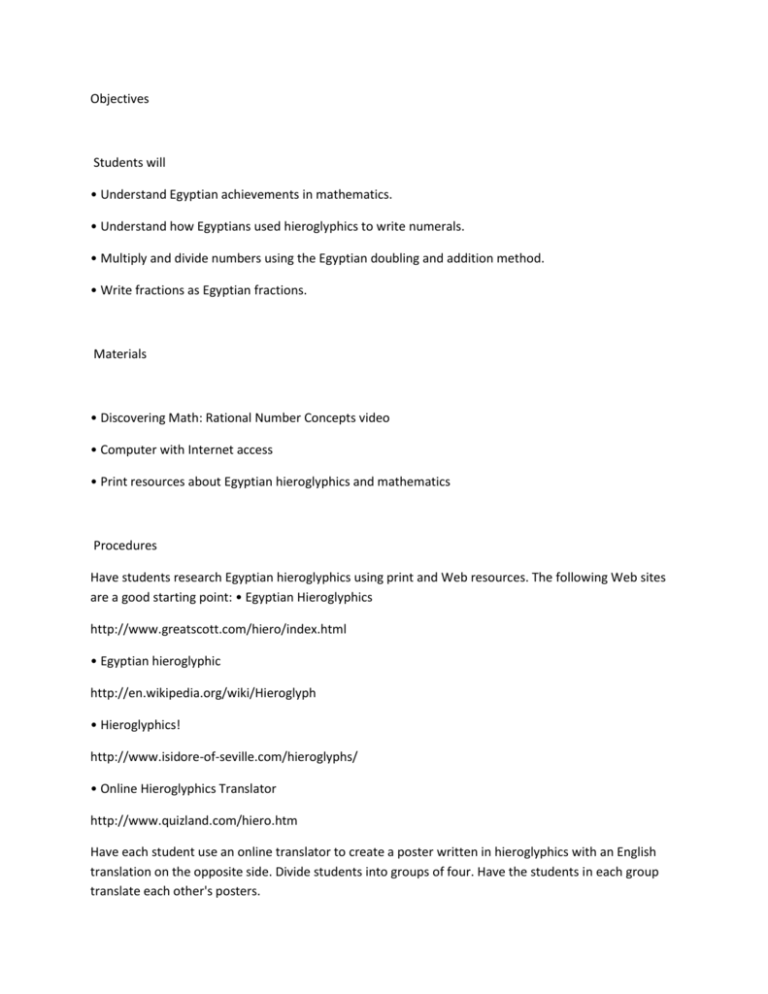
Objectives Students will • Understand Egyptian achievements in mathematics. • Understand how Egyptians used hieroglyphics to write numerals. • Multiply and divide numbers using the Egyptian doubling and addition method. • Write fractions as Egyptian fractions. Materials • Discovering Math: Rational Number Concepts video • Computer with Internet access • Print resources about Egyptian hieroglyphics and mathematics Procedures Have students research Egyptian hieroglyphics using print and Web resources. The following Web sites are a good starting point: • Egyptian Hieroglyphics http://www.greatscott.com/hiero/index.html • Egyptian hieroglyphic http://en.wikipedia.org/wiki/Hieroglyph • Hieroglyphics! http://www.isidore-of-seville.com/hieroglyphs/ • Online Hieroglyphics Translator http://www.quizland.com/hiero.htm Have each student use an online translator to create a poster written in hieroglyphics with an English translation on the opposite side. Divide students into groups of four. Have the students in each group translate each other's posters. Have students research the pyramids of Egypt using print and Web resources. The following web sites are a good starting point: • NOVA Online/Pyramids -- The Inside Story http://www.pbs.org/wgbh/nova/pyramid/ • Egyptian pyramids http://en.wikipedia.org/wiki/Egyptian_pyramids • Egypt Pyramids Index http://www.touregypt.net/featurestories/pyramids.htm When students have completed their research, ask them to summarize their findings in a one-page report. Have each student choose a partner. Ask students to share their reports with their partners and answer any questions. Then have students summarize their partner's report for the class, including at least three interesting facts. Have the students write Egyptian hieroglyphic symbols for the numbers 1; 10; 100; 1,000; 10,000; 100,000; and 1,000,000. Ask students how the Egyptians would write the number 356. (Use three-100 symbols, five-10 symbols, and six-1 symbols). Ask students why a symbol for zero was not necessary. (Each symbols represents a powers of 10. A number like 104 would be written with one-100 symbol, no 10 symbol, and four 1-symbols.) Show students examples of multiplying two whole numbers using the doubling and addition method. Allow students time to practice. Show students examples of dividing two whole numbers without no remainder using the doubling and addition method. Allow students time to practice. Show students examples of rewriting fractions as unit fractions. Allow students time to practice. Show students examples of multiplying a whole number and a mixed number using the doubling and addition method. Allow students time to practice. Evaluation Use the following three-point rubric to evaluate students' work during this lesson. • Three points: Students were highly engaged in class discussions; produced complete reports including all of the requested information; clearly demonstrated the ability to multiply two whole numbers, multiply a whole number and a mixed number, and divide two whole numbers with no remainder using the doubling and addition method; and clearly demonstrated the ability to write fractions as unit fractions. • Two points: Students participated in class discussions; produced an adequate report including most of the requested information; satisfactorily demonstrated the ability to multiply two whole numbers, multiply a whole number and a mixed number, and divide two whole numbers with no remainder using the doubling and addition method; and clearly demonstrated the ability to write fractions as unit fractions. • One point: Students participated minimally in class discussions; created an incomplete report with little or none of the requested information; were not able to multiply two whole numbers, multiply a whole number and a mixed number, or divide two whole numbers with no remainder using the doubling and addition method; or did not clearly demonstrate the ability to write fractions as unit fractions. Vocabulary Egyptian fraction Definition: A fraction expressed as a sum of unit fractions, where all of the unit fractions in the sum are different Context: Expressed as an Egyptian fraction, greedy method Definition: An algorithm that generates an Egyptian fraction from a given fraction by finding largest denominators first Context: The first step in the greedy method for converting to an Egyptian fraction is to divide 23 by 11. Then round the answer up to the next whole number and find the reciprocal of the rounded number. . rounds up to 3. is the largest unit fraction in . hieroglyphics Definition: The picture script of the ancient Egyptians Context: The study of ancient Egyptian history was made easier by translating the hieroglyphic symbols found on the walls of temples and tombs. multiplicand Definition: A number that is to be multiplied by another number Context: In the multiplication 6 ' 7, 7 is the multiplicand. multiplier Definition: A number by which another number is to be multiplied Context: In the multiplication 6 ' 7, 6 is the multiplier.
